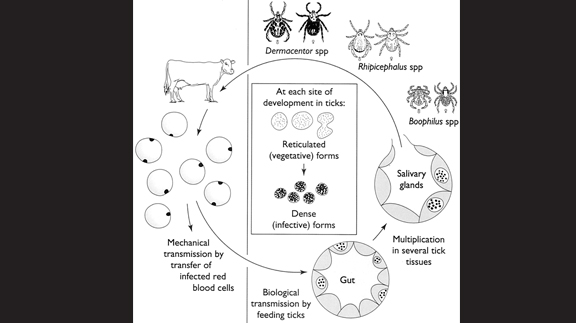Farm & Ranch
What is anaplasmosis?

By Jessica Crabtree and Dr. Jered Harlan
Anaplasmosis typically appears in fall months. Why you ask? It is because symptoms of the disease appear 21 to 45 days after infection, after fly season in late summer. Anaplasmosis has been prevalent more in the southern states.
What is anaplasmosis? It is a vector-borne, infectious blood disease in cattle caused by the rickesttsial parasites – Anaplasma marginale and Anaplasma centrale. Vector-borne are diseases that are transmitted among their human, animal or plant hosts by arthropods, usually insects, but also even surgical instruments. It is also known as yellow-bag or yellow-fever according to thecattlesite.com. Simply put, it is an infectious disease of cattle that causes destruction of red blood cells. Once infecting the blood cells, anaplasmosis causes severe anemia. It is mostly spread by ticks.
A document from the Texas Agriculture Extension Service about anaplasmosis in beef cattle, printed in 1992, divided the disease into four stages: incubation, developmental, convalescent and carrier. Incubation starts with infection of Anaplasma marginale and lasts until one percent of the animal’s red blood cells are infected. To read more pick up the February 2016 issue of NTFR.
Farm & Ranch
Hazards of Backyard Poultry

By Barry Whitworth, DVM
Having backyard poultry is a popular agriculture enterprise. According to the United States Department of Agriculture, 0.8 percent of all households in the United States have chickens. People keep chickens for a variety of reasons with table eggs being one of the more common reasons.
Unfortunately, some of these poultry producers are not aware of the hazards that come with keeping poultry because many times they carry pathogens but appear healthy.
Chickens are carriers of several zoonotic diseases. These are diseases that can be passed from animals to humans. According to a recent survey in Pennsylvania, a majority of backyard poultry producers were aware of the dangers of avian influenza. However, this study also revealed that far fewer producers were aware of the risk of possible exposure to Salmonella and Campylobacter.
The lack of knowledge about the hazards of raising poultry likely contributes to the continued issues of Salmonella outbreaks associated with backyard poultry. In 2023, the Centers for Disease Control and Prevention reported 1,072 illnesses of Salmonella linked to backyard poultry, and 272 of those patients required hospitalization. Oklahoma reported 43 individuals with the disease.
To read more, pick up a copy of the April issue of NTFR magazine. To subscribe by mail, call 940-872-5922.
Farm & Ranch
Ag Elsewhere: Wyoming

By Tressa Lawrence
Babies are tucked away in every nook and cranny. Many ranchers across Wyoming have baby animals popping up all over this time of year.
Farm & Ranch
Ag Elsewhere: Montana

By Lindsey Monk
Another load of grain in to keep feeding the calves until the green grass can really start popping.
-

 Country Lifestyles1 year ago
Country Lifestyles1 year agoScott & Stacey Schumacher: A Growth Mindset
-

 Equine7 months ago
Equine7 months agoThe Will to Win
-

 Country Lifestyles7 years ago
Country Lifestyles7 years agoStyle Your Profile – What your style cowboy hat says about you and new trends in 2017
-

 Country Lifestyles4 years ago
Country Lifestyles4 years agoAmber Crawford, Breakaway Roper
-

 HOME7 years ago
HOME7 years agoGrazing North Texas – Wilman Lovegrass
-

 Country Lifestyles7 years ago
Country Lifestyles7 years agoDecember 2016 Profile, Rusty Riddle – The Riddle Way
-

 Country Lifestyles8 years ago
Country Lifestyles8 years agoJune 2016 Profile – The man behind the mic: Bob Tallman
-

 Outdoor9 years ago
Outdoor9 years agoButtercup or Primrose?






